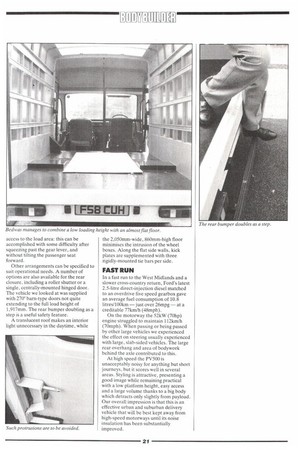BIG OPERATOR
Page 120

Page 121

If you've noticed an error in this article please click here to report it so we can fix it.
• The Bedwas range of integral parcel van bodies provide a larger capacity than is normally available from standard factory-built panel vans.
Based on the long and short-wheelbase Ford Transit chassis cowls, the PV400 and PV300 offer load volumes of 11.48 and 8.68m3 (410 and 310ft3) respectively and now, using the extra-long 3.47m wheelbase chassis, Bedwas has introduced the PV500, boosting the volume to 14.28m3 (510ft3).
Its larger capacity is derived from a 3,715mm deck length, some 720mm longer than the next model in the range. The extra length incurs a weight penalty of 100kg, reducing payload to 1,400kg.
The GRP streamlined body is claimed to benefit all-round performance, particularly fuel returns, when compared with a comparable Luton-bodied chassiscab.
On the inside, GRP panels blend in well with the front cowl and windscreen surrounds which incorporate the Ford fascia, instruments and heating and ventilation controls.
Large (680mm-wide) sliding doors on either side of the driving compartment are much improved from earlier models, being fitted with an inner skin, while rubber and bristle door surrounds provide an effective seal. However one area that could still be improved on is the door retention catch. While it works well enough it is shaped like a bayonet and looks just as lethal.
LOW STEP
The wide door and low step height give easy access to the driving seat; the large side windows forward of the doors are essential to visibility (restricted to some degree by the thick A-posts) and allow a good sighting of the rearview mirrors.
A full-height half-width wire mesh bulkhead behind the driver's seat allows access to the load area: this can be accomplished with some difficulty after squeezing past the gear lever, and without tilting the passenger seat forward.
Other arrangements can be specified to suit operational needs. A number of options are also available for the rear closure, including a roller shutter or a single, centrally-mounted hinged door. The vehicle we looked at was supplied with 270° barn-type doors not quite extending to the full load height of 1,917mm. The rear bumper doubling as a step is a useful safety feature.
A translucent roof makes an interior light unnecessary in the daytime, while the 2,050mm-wide, 860mm-high floor minimises the intrusion of the wheel boxes. Along the flat side walls, kick plates are supplemented with three rigidly-mounted tie bars per side.
FAST RUN
In a fast run to the West Midlands and a slower cross-country return, Ford's latest 2.5-litre direct-injection diesel matched to an overdrive five speed gearbox gave an average fuel consumption of 10.8 litres/100km — just over 26mpg — at a creditable 77krn/h (48mph).
On the motorway the 52kW (70hp) engine struggled to maintain 112km/h (70mph). When passing or being passed by other large vehicles we experienced the effect on steering usually experienced with large, slab-sided vehicles. The large rear overhang and area of bodywork behind the axle contributed to this.
At high speed the PV500 is unacceptably noisy for anything but short journeys, but it scores well in several areas. Styling is attractive, presenting a good image while remaining practical with a low platform height, easy access and a large volume thanks to a big body which detracts only slightly from payload. Our overall impression is that this is an effective urban and suburban delivery vehicle that will be best kept away from high-speed motorways until its noise insulation has been substantially improved.








































































































































